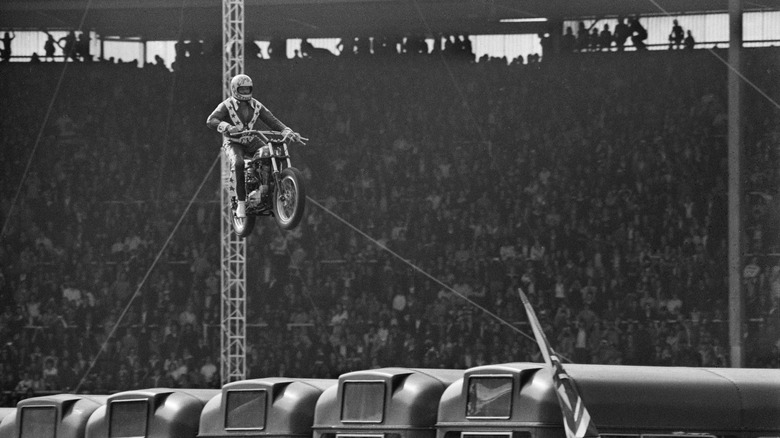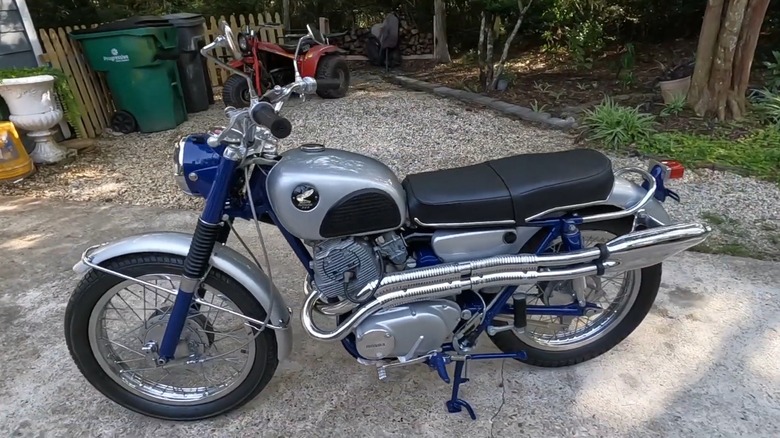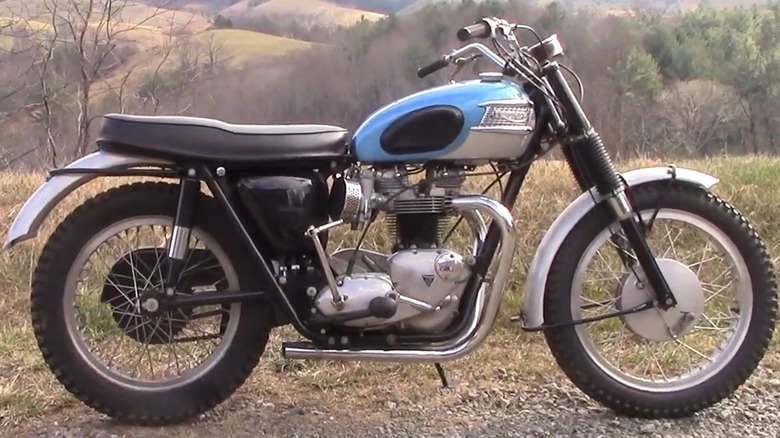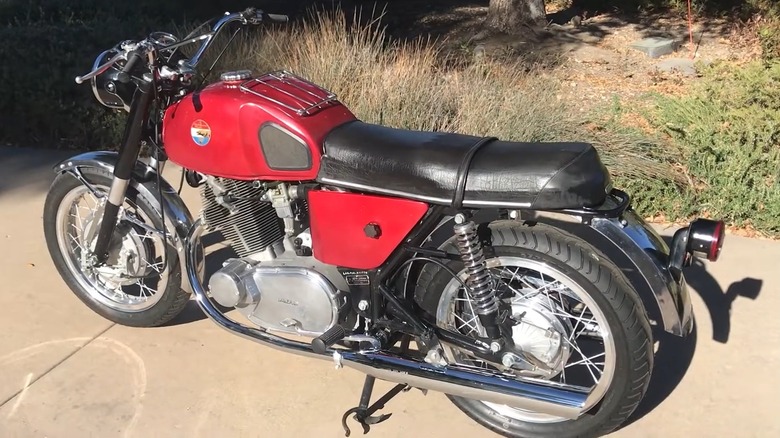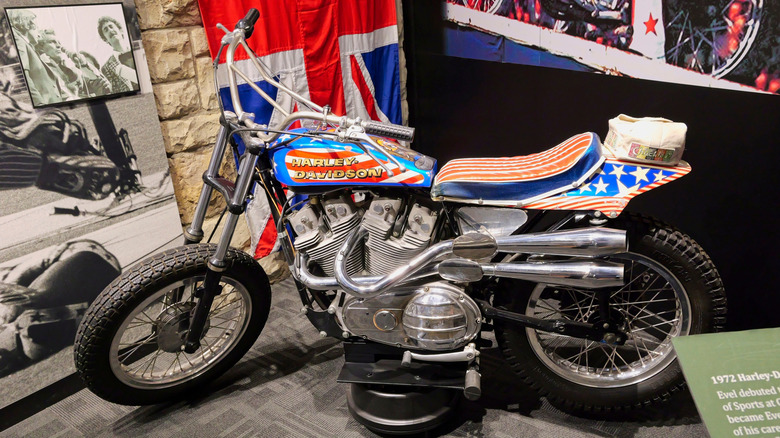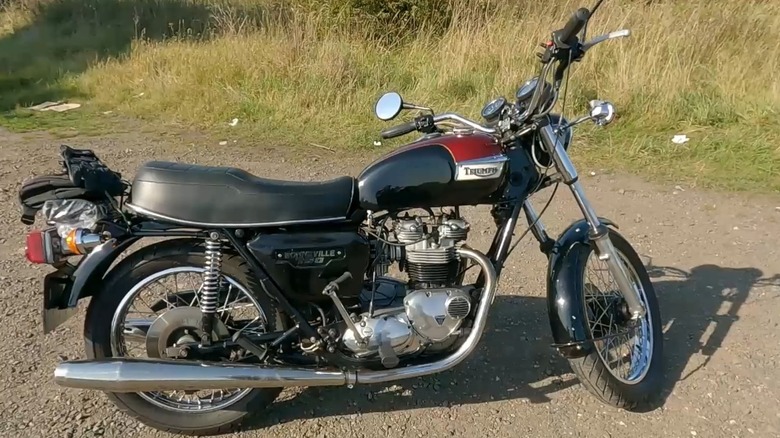What Kind Of Motorcycle Did Evel Knievel Ride?
Few events could draw a crowd quite like classic stuntman Evel Knievel attempting a new record while flirting with death. During his career, which would span decades, Knievel would make more than 300 jumps on a variety of motorcycles from brands like Honda, Triumph, Laverda, and Harley-Davidson.
In the late 60s, Knievel would become known throughout the world when he dared to jump a motorcycle over the Caesar's Palace casino fountain in Las Vegas. As spectators amassed in the thousands, Knievel would travel more than 140 feet in the air. But something went wrong as he tried to land the bike, causing a horrific crash. While Knievel suffered several broken bones and was in a coma for around a month, he survived, and continued pushing the envelope of what was thought possible.
A look behind the scenes makes Knievel's daredevil stunts even more frightening, as these motorcycle jumps weren't conceived using sophisticated scientific models or simulations, but instead were born from some calculations and estimates hastily scrawled on the back of paper napkins. According to John Derek, who was filming a documentary around the time of the ill-fated Caesar's Palace stunt, Knievel expressed doubt to him that he would successfully complete the jump as reported by RideApart.com. However, in a move some would call courageous and others perhaps crazy, Evel lined up for the leap all the same.
The Honda CL 305 Scrambler
Honda's 1965 305 Scrambler came equipped with a 305cc engine and was designed for use on and off roads, giving it enhanced versatility. Some expert reviews at the time described the impressive suspension travel on the front forks, and noted that only under severe circumstances would the rear bottom out with a passenger on back.
Others noted that the suspension setup limited how much the rider would bounce following impact, which would conceivably aid in better control during challenging scenarios. Honda also crafted a unique frame to help protect the engine, and incorporated strategic skid plate positioning, making it clear engineers planned on these bikes taking a beating.
Evel Knievel began performing jumps on the CL 305 Scrambler as a promotional tool to attract customers to his Honda dealership in the mid-60s. Some of his stunts included leaping over dangerous animals, such as a mountain lion and rattlesnakes. In addition to the strong suspension, and robust frame, scramblers in general include exhaust pipes set higher on the frame, enabling superior ground clearance. This Honda also only tipped the scales at 337 pounds, allowing for easier control and making it a good choice for stunts.
Triumph T120 TT Special 650cc
This Triumph racing bike was in production from 1963 through 1967 and was exclusive to the US. It featured a larger 650cc overhead valve parallel twin engine that output 52 horsepower and had a reported top speed of 120 miles per hour. With its robust performance and a dry weight of 350 pounds, the Triumph T120 TT Special was used by Knievel as a trick bike.
The stuntman was observed using this specific motorcycle just prior to the Caesar's Palace jump, where he was popping wheelies to get the crowd pumped before the main event. According to CJOnline.com, Evel usually brought a few motorcycles to his show, where one would be used for wheelies and the other for the big stunt.
However, according to Triumph, Evel Knievel had much bigger plans for the heavily modified T120 TT Special — including jumping over the Grand Canyon. The kitted-out bike was referred to as "Skycycle" by the daredevil, but unfortunately, the National Park Service put the kibosh on the entire idea, leading Evel to relocate his jump to Snake River Canyon.
Laverda American Eagle S Model 750cc
In the late 60s, Italian motorcycle manufacturer Laverda decided that the best way to attract US riders was with more displacement. The American Eagle came in a few variants, but the more robust of the two included a 750cc twin-cylinder four-stroke engine. One expert take on this bike from the era explained that on the road, the American Eagle offered fantastic performance with just the right amount of power, maneuvering capability, and refined ride. If you haven't heard of Laverda, you're not alone, as it's one of the Italian motorcycle brands that many might not realize exist, even though it had a good run until 2004, and is popular with collectors.
Knievel was commissioned to help the brand gain notoriety in the US and given two American Eagles to ride. Evel ended up using them for more than a dozen big stunts between 1969 and 1970. Unfortunately, loaded up with fuel and with a rider, the American Eagle 750cc was reportedly close to 690 pounds.
For motorcycle jumps, a heavier bike meant that in the event of a crash, Knievel was at greater risk for serious trauma. It's unclear if it was simply bad luck or the bike itself, but of the 13 leaps he undertook with the American Eagle, six of them resulted in a crash.
Harley-Davidson XR-750
Widely considered one of the most iconic motorcycles from the 1970s, the XR-750 from Harley-Davidson was a championship-winning dirt bike that was certainly outside the cruiser genre the manufacturer was famous for. The stock version was equipped with a 750cc v-twin engine that could output 80 horsepower and featured cast-iron heads.
Knievel successfully leapt over 19 vehicles, setting a world record on a modified XR-750, which included his iconic patriotic American paint scheme. Although the stuntman would upgrade when Harley-Davidson swapped out the iron heads for aluminum, which lessened the overall weight of the bike and aided in thermal management.
The stuntman favored the XR-750 for its lightweight design, and tried-and-true build. Weighing in at around just 300 pounds, this machine allowed Knievel to travel up to 165 feet through the air.
Unfortunately, this was also the bike used on the failed jump at Wembley Stadium, where after almost clearing 13 double-decker buses, his landing sent him flying off the bike. One of Evel's Harley-Davidson XR-750 motorcycles is on display at the Smithsonian's National Air and Space Museum, along with a quote from the man himself, "Anybody can jump a motorcycle. The trouble begins when you try to land it."
Triumph Bonneville T140 750cc
The Bonneville T140 (particularly the T140J Silver Jubilee) is considered by many to be one of the most stylish Triumph motorcycles ever designed, and is perhaps responsible for the brand still being around today. Made as a more performance-oriented tourer, the Bonneville T140 was capable but also ergonomic. This bike included a 744cc air-cooled engine that produced 49 bhp or brake horsepower, which is different from regular horsepower.
For Evel Knievel, he would ride the Bonneville T140 in the last few public events he took part in before retiring. Due to the number of bone-breaking injuries the stuntman accrued during his career, by the late 70s he opted to act as an announcer at stunt shows, introducing younger up-and-coming stunt riders. Although, he still pulled off wheelies for the crowd as he had always done.
Many classic motorcycle fans covet the Bonneville T140, and one described that his favorite aspect of it was the handling, due to its lightweight design. This could very well be the reason Knievel chose to perform tricks with it as well.
